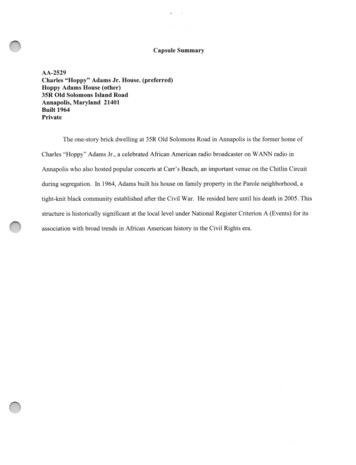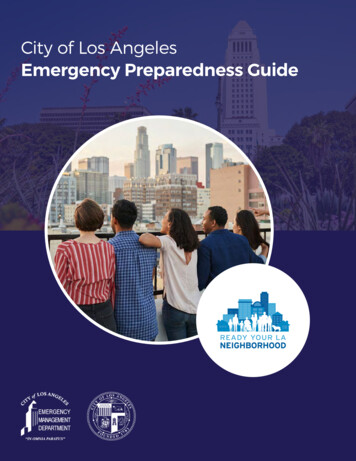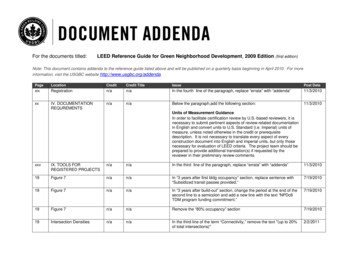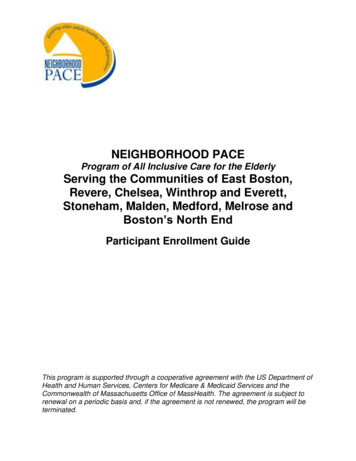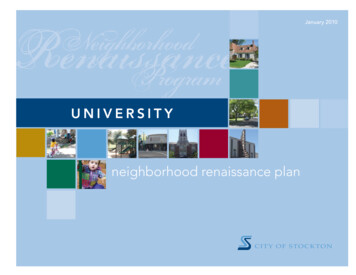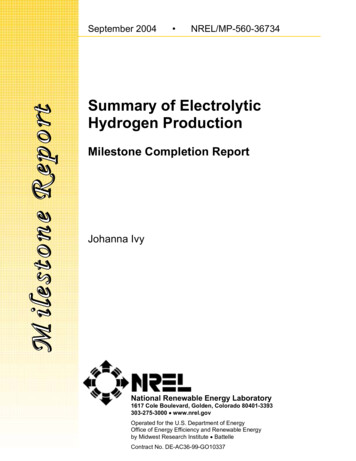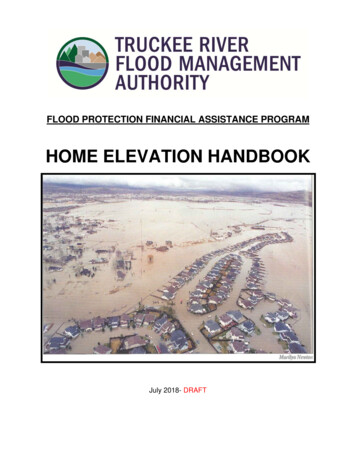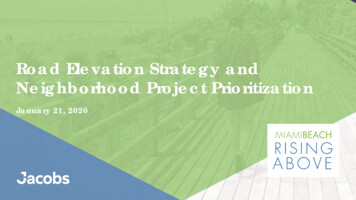
Transcription
Road Elevation Strategy andNeighborhood Project PrioritizationJanuary 21, 2020
Meeting Outline Purpose Jacobs is finalizing their recommendations Our team is here to listen Use comments/questions received to inform final recommendations Providing a comment Speak during the meeting, or Submit comments/questions after the meeting Comment ground rules during meeting: Form a line to ask a comment/question Speakers are limited to 2 minutes Online viewers email questions to: MBRisingAbove@miamibeachfl.govBI0909191410MIA2
Comments After the Meeting Open comment period through January 24, 2020 Questions on Citywide Stormwater Management? Please contact:Liz Bello-MatthewsPublic Information Officer – Public Works Department305-673-7000 ext. 6902E-mail: LizBello-Matthews@miamibeachfl.govBI0909191410MIA3
Project Leadership2523yearsyearsMatt AlvarezJuan AceitunoProject ManagerDeputy Project Manager/Implementation Task LeadBI0909191410MIALaurens van der TakClimate AdaptationAdvisory Panel15yearsyearsPlanning Task Leadyears2520Jason Bird30Joe RozzaBlue-Green & SustainabilityyearsMonica DiazPublic Outreach4
Agenda Road Elevation Strategy Neighborhood Project Prioritization Methodology and Criteria Questions and CommentsBI0909191410MIA5
Task 2Road Elevation Strategy
Water seeks its own levelSea LevelGroundwaterOn sunny days, groundwater levels belowMiami Beach rise and fall with sea level,because limestone geology connects theocean and groundwater.BI0909191410MIA
Tidal flooding is problematic in low-lying areasBackflowSeepageBI0909191410MIA
Tidal Flooding increased with RainfallDrainageBI0909191410MIA
Long Term Strategy includes Elevated Roads, Sea Walls and PumpsBI0909191410MIA
Raising roads is an important strategy to address sunny daytidal flooding in public right-of-way Through storm drainsThrough groundwaterThrough overtopping of coastal barriers (e.g., seawalls)Exacerbated by Sea Level Rise OCEAN
Road Elevation Strategy Overview Intent of Updated Policy Incorporate updated tide data and SLR projections Improve harmonization with private propertyROADWAY HARMONIZATION:A roadway design approach thatmaintains private property access,stormwater management, andneighborhood aesthetics throughadaptable design standards. Current Policy Minimum road crown elevation for all roads: 3.7 ft NAVD (established2014) Draft Policy Approach Flexible design options to address local needs and conditions Address access, stormwater, and aesthetics while reducing flood risk Tiered road elevations based on road classification Alternative strategies to design road elevation below minimum elevationcriteria if constrained by harmonization with private propertyBI0909191410MIA12
Guiding Principles of New Road Raising Strategy Support keeping road surfaces above the king tide elevation to avoidsunny day tidal flooding Establish new minimum elevations for City roads based on updatedtidal records and SLR projections Address increasing groundwater elevations and concern for poorpavement performance, including premature pavement failurerelated to saturated road base Address concern for private property harmonization Standardize application so policy is unbiased, objective, andtransparent Consider cost implicationsBI0909191410MIA13
Key Factors that Influenced Current 2014 Road ElevationDesign GuidelinesRecommended Road Elevation A B CA. Historical “King Tide” 1.7 ftNAVD*B. Sea Level Rise for assumedService Life of 30 years: 1.0 ftC. Freeboard(1 ft assumed for road crossslope, drainage, and roadbase)Current Road Elevation Strategy,Developed in 2014CROWN OF ROAD ELEVATIONensures that the highest point ofthe road and importantinfrastructure is above rising tides.*NAVD North American Vertical DatumBI0909191410MIA14
Summary of Key Factors that Determine Minimum RoadElevation Criteria Evaluates elevations at edge of road (EOR), not crown, and at bottomof road base (BORB), and picks the most protective standard Assumes 30-year road service life Updated Sea Level Rise projections Target frequency of flooding (applies at end of road service life): Local Roads: 50% chance per year (includes roads classified by City as“Local”, mostly residential roads) Major Roads: 20% chance per year (includes roads such as WashingtonAve. classified as “Minor Arterial” and “Minor Collector”) Emergency Roads: 10% chance per year (includes roads such as Alton Rd.classified as “Evacuation Route and access to First Responders)BI0909191410MIA15
Updated decision process calculates minimum roadelevations at two points on road sectionBI0909191410MIA16
Calculation Method 1: Limited Flooding at Edge of Road (EOR)Tide and Sea Level (ft NAVD)Measured Tides (1994-2019) at Virginia Key (ft NAVD)BI0909191410MIALong-Term Water Surface Elevation Data atVirginia Key (25 years of hourly data) is usedto estimate probability of water elevationsbeing exceeded.17
Calculation Method 1: Limited Flooding at Edge of Road (EOR)Water Surface Elevation (ft NAVD)Water Surface Elevation at Virginia Key (ft NAVD)2.34 ft water elevation has 20% chanceof being exceeded in any year(on average, once every 5 years).Annual Exceedance ProbabilityBI0909191410MIA18
Calculation Method 1: Limited Flooding at Edge of Road (EOR)results in EOR Minimum Elevation of 3.0 ft to 4.8 ft NAVDRelative Sea Level Change Scenarios for Miami Beach (NOAA*, 2017)RSLC (ft NAVD)SLR of 1.3 ft or 1.8 ft 30 years out from 2020,for NOAA Int-High or High Curves30-yr servicelife of road*NOAA National Oceanic and Atmospheric AdministrationBI0909191410MIA19
Calculation Method 1: Limited Flooding at Edge of Road (EOR)results in EOR Minimum Elevation of 3.0 ft to 4.8 ft NAVDBI0909191410MIA20
Calculation Method 2: Limited Groundwater Wetting at RoadBase during High Tide (MHHW) Results in Bottom of Road Base(BORB) Minimum Elevation of 2.9 ft NAVDNOAA Published MHHW of 0.2 ft NAVDfor 1983-2001 epoch was updated to0.6 ft NAVD based on recent tidal data.BI0909191410MIA21
Higher of two calculation methods is selected for EOR or BORBBI0909191410MIA22
Emergency Roads ̶ Minimum Elevation at Edge of Road(Method 1): 4.8 ft NAVDFor EmergencyRoads, Method 1results in higherMinimumElevation at Edgeof Road forprojects built in2020.BI0909191410MIA23
All Roads ̶ Minimum Elevation of Bottom of Road Base(Method 2): 2.9 ft, so Edge of Road is 3.9 ft assuming1-ft road thicknessMethod 2 is usedto set MinimumElevation ofBottom of RoadBase: 2.9 ft NAVDfor projects builtin 2020.BI0909191410MIA24
Major Roads ̶ Minimum Elevation of Edge of Road(Method 1): 3.6 ft NAVD, so Bottom of Road Base (Method 2):3.9 ft NAVD is preferredMethod 2:Method 1:Limited Flooding atEORLimited Groundwater/TidalWetting at BORBFor Major Roads, Method 2 results in higher Minimum Elevation at Edgeof Road, assuming projects with 1-ft road thickness and built in 2020.BI0909191410MIA25
Road raising strategy for future projects increasesin recognition of accelerating Sea Level Rise projectionsRelative Sea Level Change Scenarios for Miami Beach (NOAA, 2017)RSLC (ft (NAVD)SLR of 2.7 ft or 1.9 ft30 years out from 203030-yr from 204030-yr from 203030-yr from 2020SLR of 3.7 ft or 2.7 ft30 years out from 2040SLR of 1.8 ft or 1.3 ft30 years out from 2020Project Start Date 2020 2025 2030 2035 2040Emergency Roads(Method 1)4.85.25.76.26.7Arterial and Local Roads(Method 2) *3.94.24.54.95.3* Method2 assumes 1 ft road thickness above bottom ofroad base.BI0909191410MIA26
Harmonization with Adjacent Property If constraints are identified by the City Engineer, as a result of theminimum road elevation, then harmonization exception criteriasupersede, at the discretion of the City Engineer. Example exception criteria may include: Inadequate horizontal space to construct roadimprovements and tie back to existing grade Driveway grades and grade break cannot meet Citystandards at new elevation, posing access concerns Adverse stormwater management conditions createdBI0909191410MIA27
Harmonization with Adjacent Commercial Property Existing issue (saturatedbase causing roadsystem failures) Proposed roadelevation createsconflicts with buildings Harmonization solutionincludes use of edgetreatment to mitigateBI0909191410MIA28
Harmonization with Adjacent Residential Property Proposed roadelevation may createdriveway accessissues. Shift sidewalks todecrease angle ofslope. Raising sidewalk androadway less todecrease angle ofslope.BI0909191410MIA29
Proposed Criteria for Harmonization Driveway slopes within FDOT standards to avoidadverse conditions.Adverse Driveway Conditions Recommended maximum driveway slopes Residential: 12.5% (1V:8H) Commercial: 10.0% (1V:10H) Recommended max. sidewalk cross-slope 1.5%BI0909191410MIA30
Proposed Criteria for HarmonizationIf driveway slope changes more than 14.0% at a crest or sag, a vertical transition will be provided. RoundedverticaltransitionsAdverse Driveway ConditionsRounded Vertical TransitionsStraight Vertical Transitions StraightverticaltransitionsBI0909191410MIA31
Proposed Harmonization Solutions (Examples) Alternative road treatments (retaining walls, steps, ADA ramps, etc.) Temporary construction easement to reduce slope of driveways. Lower sidewalk at driveway to improve driveway grades. Collect stormwater from behind sidewalk, into storm drainage system. Don’t raise roadway as high as minimum standard.(solutions vary between residential and commercial property)BI0909191410MIA32
Basements DefinedFEMA Definition:Any area of a building having its floor subgrade (below ground level) on all sides.(Definition adopted and codified by City of Miami Beach, Ordinance Section 54-35)Ground levelBuilding FloorBasement ConditionBI0909191410MIAGround levelBuilding FloorNot a Basement33
Purpose of Pumps, for Stormwater Management Maintain stormwaterdischarge during high tide,allowing streets and propertiesto drain. Elevating roads mitigatesagainst high tides andgroundwater.Building FloorHigh Tide &Future SeaLevelsBI0909191410MIA34
Task 3Neighborhood Project Prioritization
Neighborhood Project GroupPrioritization Objectives Strategically guide prioritizationof City Neighborhood Projects Maximize benefits, minimizeimpactsNEIGHBORHOOD PROJECT:A project involving multipleCity Services; for example: Road improvements Water/sewer maintenance Stormwater upgrades Objective, transparent, andrepeatable methodologyOverall Process for Neighborhood Project PrioritizationCity rojectsToday’s FocusPrioritizationMethodologyGroup intoPrioritizedNeighborhoodProjects
Guiding Principles Public safety is top priority Water and wastewater service delivery and environmental protectionsupport multiple objectives Public health, local economy, regulatory compliance Economic development is supported by City services Service delivery/capacity, risk management Routine maintenance supports long-term service supply reliability Aesthetics not a stand-alone objective (but important)BI0909191410MIA37
Neighborhood Project Prioritization Development of Methodology Established 11 project categories Developed criteria for each category corresponding to level of importance(scores correspond to level of importance) Developed weight factors for each category Notes About Methodology Projects can have attributes that span multiple categories Projects with multiple benefits produce higher scoresBI0909191410MIA38
Neighborhood Project Prioritization: Eleven Categories of ProjectsProject CategoriesObjectives and Benefits of City ProjectsBrief DescriptionAestheticsBusiness visibility, landscaping, historical integrity, green streetsCoastal Flood Risk ManagementExposure and sensitivity to king tides, sea level rise, storm surge, extreme weatherEconomic DevelopmentType of developmentEmergency (Critical) Facilities and RoadsEmergency response effectivenessEnvironmental Benefits (Ecological)Type of environmental benefitsPedestrian and Bicycle MobilityInfrastructure that enables more and safer pedestrian and bicycle movementPotable Water/Fire Suppression SystemPublic safety, public health, and infrastructure conditionRain Driven Storm Water ManagementFlood management, environmental protection, and regulatory complianceRoad ClassificationType and capacity of roadSanitary Sewer Service DeliveryProvision of service, capacity and condition of systemTransportation – Road Condition/Remaining Service LifeCondition and service life of roadBI0909191410MIA39
Neighborhood Project PrioritizationRating Projects Across Multiple Categories of Objectives and BenefitsBI0909191410MIA40
Neighborhood Project PrioritizationRating Projects Across Multiple Categories of Objectives and BenefitsRankProject CategoryProject Category Weight Factor (%)1Coastal Flood Risk Management1002Potable Water Distribution / Fire Suppression System1003Emergency (Critical) Facilities & Roads904Sanitary Sewer Service Delivery855Rain Driven Storm Water Management856Environmental Benefits707Economic Development608Pedestrian and Bicycle Mobility509Road Classification4010Road Condition Maintenance4011Aesthetics35BI0909191410MIA41
Example Application Scoring and Prioritizing Projects1. Identify all projects in the Neighborhood ProjectGroup2. Develop score for each project:1. Can involve multiple categories2. Select single attribute that best represents the project3. Apply category weight factor to each attribute value4. Add up scores for project to get total project score3. Add total project scores for all projects inNeighborhood Group for overall score for thatgroup4. Use overall Neighborhood Project Group score tocompare and prioritize multiple NeighborhoodProject GroupsBI0909191410MIA42
Neighborhood Project Group 1 (Hypothetical)BI0909191410MIA43
Neighborhood Project Group 2 (Hypothetical)BI0909191410MIA44
Neighborhood Project Group 3 (Hypothetical)BI0909191410MIA45
Example: Ranking and Prioritizing Multiple Projects GroupsHighestPriorityProjectBI0909191410MIA46
Thank YouFor Getting Involved
CommentsFrom The Public
Planning Task Lead. years . 20. Joe Rozza Blue-Green & Sustainability. years . 25. Monica Diaz. Public Outreach. years . 15. BI0909191410MIA Agenda Road Elevation Strategy Neighborhood Project Prioritization Methodology and Criteria Questions and Comments 5. Task 2 Road Elevation Strategy. BI0909191410MIA Water seeks its own .

